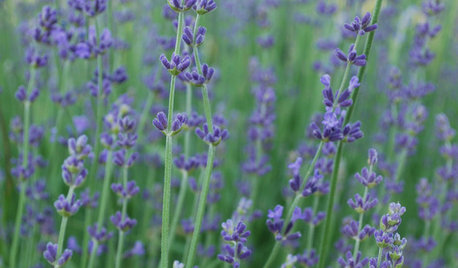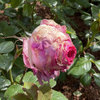Here is a record of my processes, decisions and interpretations of what I experienced while trying to grow a tree rose indoors over the winter. If you scroll down you will see large blooms, lighting conditions, etc.
Geminis condition before I brought it indoors:
Since I only do organics, GeminiÂs organic fertilization with Gardenville Sea Tea ended in mid-October. No synthetic fungicides were applied, only organic DrammaticK (raw fish emulsion) and Greencure mixed together as a foliar blackspot buffer. Incessant rains are still in full force so the application was very sparse and irregular, the last application being 5 days before bringing the tree rose in. All my East-facing/full sun backyard roses became full-shade roses starting in September because of the way the sun was cast.
Why I decided to grow my Gemini tree rose indoors: I wanted the winter buds to bloom:
Sometime in July, a few of us here at the rose forum were discussing growing roses indoors during winter. I volunteered but changed my mind in late August when my once healthy, pristine 1st year grown-Gemini tree rose became very sick with blackspot due to excessive record-breaking rains in Kansas City after it had an incredible gorgeous flush of blooms. Gemini severely defoliated, but then made another foliage comeback in October. I was going to let the rose go dormant in the garage as soon as the weather fell in the lower 20s. Much to my shock, at the end of the November when the weather started to get really cold (below 32 degrees during the day and 25 degrees at night, Gemini produced 14 fat blossom buds. Then on November 30th the 2nd day of weather finally hitting 28 degrees/day with 18 degrees/night, I placed Gemini right in my entryway where I observed that it would get the most sun, and stuck the rest of my potted roses in the garage.
Indoor conditions for Gemini:
1. Entryway faces West. West is normally full shade during summer but becomes full sun in winter. Gemini gets most of its sunlight from the upper level arched window. The very narrow door sidelights are too minimal to let in much sun. To the back of Gemini are my large kitchen windows. Whenever I go to sleep at night I open all the shades of my kitchen and the door sidelights to let in maximum sunlight as soon as the sun rises. See the 2 enclosed photos to see the set up of my house to compare the sunlight locationsÂ
2. DrammaticK stinks to high-heaven even though 5 days had passed since I last applied it outdoorsÂhad to use 2 Airwick room deodorizers, LOL! I noticed moderate to light blackspot on Gemini. So I decided to use a mix of horticultural oil/Greencure instead of DrammaticK/Greencure to avoid the stench. I have hardwood floors so mopping the excess droplets was pretty easy.
Day Two: One or two flower sepals began to unpeel for some of the blooms. Gradually more and more sepals opened as the days passed by. Day Three: I use my favorite Gardenville Sea Tea to feed Gemini. Buds continue to increase in size. Day 4Finally! white completely closed petals were visible, sepals completely pull back for a few key buds. Day 5 actual blooming officially begins with decent-lasting blooms (over 2 weeks longevity).
Example of beginning bloomsÂ
Maturing to thisÂ
Dramatic change in color and scent: My fragrance sport Gemini becomes slight fragrance instead. Color goes from deep coral and cream mix to soft shell pink.
Outdoors:
Indoors:
Crisis: Hack and Slash on December 18: During the blooms, Blackspot becomes severe again, the worst ever because it was spreading spots to the actual stems themselves. All the sick and nasty leaves were mixed in with healthy leaves. Blackspotted leaves were shedding all over the floor. In desperation I decide to let only 9 of my 14 flowers finish into mature blooms and then stuck them all in 2 vases. I then hacked away huge chunks of leaves, stems parts of canes. All the old leaves, whether diseased or undiseased were completely removed except for a tiny cluster on the far left end of Gemini (in front of the black coat corner). My intention was to force Gemini into a drastic artificial dormancy state. I only decontaminated my shears with 405 bleach about 20% of the time (no patience because there was too much of the plant I had to cut). I then hand-sprayed my horticultural oil/Greencure mix immediately. A day later I sprayed the potted soil (not the leaves!) with organic sulfur (SaferÂs brand, no lime) All branches and stems were bare, except for beginning bud protrusions and that tiny cluster of non-diseased leaves. Gemini is unstoppable. Here are photos of all the new growth it produced. It took just a week-and-a-half for them to push out all this growth. Sadly I should have taken a comparison photo of Gemini as soon as I completely hacked it so you could all see the dramatic change--whoops!
Brand new foliage on December 23:
Foliage December 27:
December 28: applied 2nd round of Horticultural Oil/Greencure
Foliage December 30:
Significant change in leaf foliage: Normally Gemini produces very thick green and waxy foliage and its baby stems are a gorgeous and unique Auburn color. Now GeminiÂs leaves are very thin and an ordinary green and it has lost its auburn coloration.
Outside foliage:
The majority of the new leaves are curled I suspect because they are stressed by the too-strong concentration of Horticultural oil/Greencure. I was forced to use a stronger Greencure concentration than was recommended because I didnÂt want to risk the blackspot resurfacing because the blackspot had gotten so severe. The canes seem to really like the oil mix though. Canes are a very deep green, deeper than when outdoors. The leaves eventually start to uncurl a bit more, but this type of curling I am sure would not have happened if the Greencure was at its normal dose. Only time will tell if Gemini will be strong enough to bloom prior to April and if it remains this pristine. I almost suspect that if it does try to bloom again, blackspot will strike. It seems to be a pattern with my Gemini. It will go crazy with blooms and then get sick again!
I will update this thread as my experiment continues. We still have January  March to see if Gemini can remain as pristine/blackspot free as it currently is I will do my 2nd Gardenville Sea Tea feeding today-December 30th. Unlike DrammaticK, Gardenville Sea TeaÂs odor does not linger. I will also be interested to see whether any young foliage ever develops to a thicker, darker green. I suspect not, but we will seeÂWill it bloom again? HmmÂ.A welcome improvement of indoors vs. outdoors is the control I have. I can view all the leaves from my stairway, whereas in the past, Gemini was too tall for me to reach and monitor closely for blackspot. I donÂt have to worry about nasty incessant rains ruining my organics protection regimen either or blackspot spreading spores everywhere through the rain! Another thing is that I have no problems with spider mites in my home. Perhaps the oil protects Gemini from them. I believe that had Gemini been a healthy, blackspot-resistant rose, it would have truly flourished in my home and would have produced another flush while indoors because all of its thick, dark green mature leaves would have survived. My sport-fragranced Gemini is highly vulnerable to BS and so the new leaves are far more tender/with some damage because of the excess Greencure I had to use. IMHO leaves are essential for feeding the plant and the blooms so if GeminiÂs leaves donÂt thicken up and grow dark, they may be too tender to support any sort of blooming. Also Gemini for the first time since August is finally beginning to grow evenly like a healthy rose should grow. It used to be so top-heavy with a forest of thick upper foliage but naked on the bottom because of the BS defoliation. Gemini is finally looking well-proportioned.
Theories to test: If Gemini remains pristine, it may help correlate that BS is truly weather/moisture related since organics is only a mere buffer against BS. My problems with BS did not strike until we got incessant rains and when my "East-facing" roses shifted from full sun to full shade. If Gemini produces another flush before April it will again prove that adequate lighting conditions (just window light, no fluorescents) can still produce a strong, blooming rose. I very! much doubt the latter will happen however. I doubt there will be another flush until Gemini is put back outside. Question: did the combination of icy cold and diminished window light both contribute to GeminiÂs change of bloom color? Or was it just the light factor. My guess is that it was just the window light factor. If Gemini does bloom and remains that shell pink color before April the cold factor will be eliminated and it means that light was the deciding factor. Next experiment: Decreasing the frequency of horticultural oil/Greencure to reduce leaf damage.















hoovb zone 9 sunset 23
karl_bapst_rosenut
Related Discussions
Gemini tree rose
Q
Bardou Job, from the 1888 Journal of Roses
Q
Growing Roses From Seed indoors
Q
Growing Roses Indoors?
Q
jim1961 / Central Pennsylvania / Zone 6
jont1
Krista_5NY
petaloid
serenasyhOriginal Author